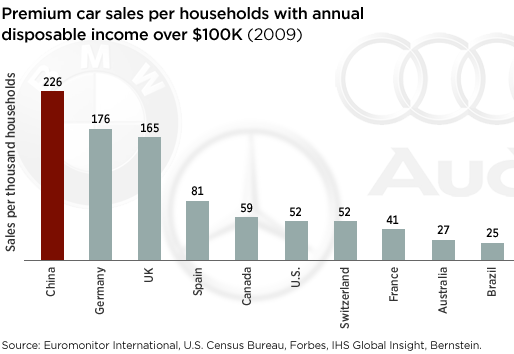While overall consumer spending continues to fluctuate this year between marginal growth and zero growth, luxury spending is experiencing a rebound. Often considered a harbinger for consumer spending in general, global luxury goods sales rose 15% in the first quarter of 2010 alone, compared with a year ago. And many individual luxury companies have reported anywhere from 15% to 30% organic growth from mid-2009 through August of this year.
What is your view of the uptick in global luxury spending?
The rapid recovery in the luxury sector has been driven by recovery in equity markets worldwide, which actually started in early 2009, as well as the continued growth in emerging markets. We expect to see ongoing strength in the sector — largely outside of the United States — that could continue to drive growth into 2011.
Where is the growth coming from?
Much of the growth is being driven by China, where a wealthy consumer class is emerging rapidly and gravitating largely to European luxury goods at a pace faster than its U.S. and European counterparts. In fact, it’s estimated that China and Japan together represent about 40% of the worldwide luxury market today. To take advantage of the trend, many luxury goods companies are opening new retail outlets in China. Gucci, for example, currently has 35 stores in China and expects to open 6 to 12 new stores each year for the next three years. (As of September 30, 2010, parent company PPR represented 1.74% of the portfolio.)
Luxury spenders are also buying cars. A study of premium auto sales by Bernstein Research found that German manufacturers such as BMW and Mercedes were already deriving more than 50% of their profits from China. In the second quarter alone, BMW sales in China were up 99% and Mercedes sales were up 201% compared with the same time last year. (As of September 30, 2010, BMW represented 2.00% of the portfolio, and Mercedes was not held in the fund.)
Surprisingly, we are also seeing an increase in spending from the European domestic luxury consumer, likely buoyed by rising equity markets and increases in personal income.

How might these trends affect stock selection in Putnam Global Consumer Fund?
The fund has a large weighting in the luxury goods sector, and we have de-emphasized other areas, such as mass-market retail and those sectors more exposed to developed markets. Luxury goods stocks have performed well since the beginning of 2010, but we believe there may be further performance upside to the stocks, given the companies’ superior fundamentals, in our view.
There are two additional factors supporting our view. First, growth in emerging markets is expected to continue. In its July outlook, the International Monetary Fund projected that emerging and developing economies would surpass advanced economies, with estimates of 6.8% growth for 2010 and 6.4% for 2011, compared with 2.6% for 2010 and 2.4% for 2011 for developed nations.
Second, while the pace of newly minted millionaires in the United States has waned, the wealthy population in China continues to rise. Bernstein Research indicates that the number of Chinese millionaires could nearly double by 2015, and the number of Chinese with incomes higher than $100,000 may increase by 94% by 2015. The likelihood that these increasingly wealthy consumers will continue to crave global luxury brands remains high.
Putnam Equity Research Analyst Sarah Marshall contributed to this post from London.
More in: Equity, Global sector, International



